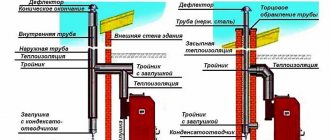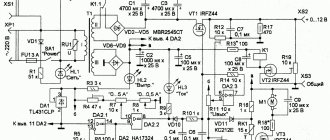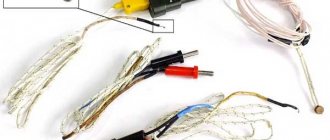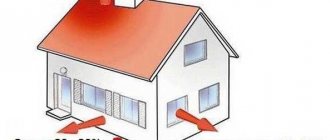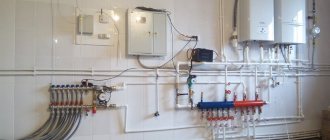More than one or two varieties of heating appliances have been invented, but the leadership position in terms of demand and sales level has long been firmly entrenched in gas boilers.
Both potential buyers and existing owners should have a good understanding of these units in order to be able to carry out feasible repairs and have a good understanding of the essence of preventative maintenance.
The reader is invited to study the structure of a gas boiler and become familiar with the purpose of all its components.
The principle of operation of a gas boiler
This equipment operates according to an extremely simple scheme. Natural gas is mixed with air to form a fuel-air mixture that is ignited. The flame and hot products of fuel combustion heat the contents of a special tank - a heat exchanger, which is connected to a heating system (CO) with a liquid coolant.
The latter constantly circulates through the system - either only due to convection (natural circulation), or also due to the operation of a special pump (forced circulation).
Installation of a wall-mounted double-circuit gas boiler
Flue gases, having given up part of their available energy to the coolant, are discharged outside through the chimney.
Along with conventional boilers, so-called condensing boilers are produced today. They “know how” to take more heat from the flue gases, so that they cool down to the condensation temperature of the water vapor they contain.
It is condensation that acts as the source of the main part of the additional heat (the processes of changing the state of aggregation are very energy-intensive). As a result, the efficiency of the installation increases to 97% - 98%.
Diagram of operation of a device serving two circuits
It is not possible to use a dual-circuit device to simultaneously heat the room and water supply. As soon as the water tap is activated, the movement of the coolant through the heating mechanism stops.
If the heated liquid is used for household purposes in too large quantities, the possibility of interruption in the operation of the boiler in terms of heating cannot be ruled out. There are two ways to get out of this situation: install a more powerful unit or add a boiler to the complex.
If DHW is used intensively, it would be optimal to install a device with a built-in heating device. Fuel consumption will, of course, increase, but not by much. This is explained by the fact that in the intervals between functional cycles the burner ensures that the temperature of the water in the additional water heater is maintained.
The reserves located in the built-in boiler make it possible to use water without turning off the heating circuit, which allows you to obtain the required temperature at the right time, automatically providing a sufficient amount.
Operation of a double-circuit gas boiler with a flow-through heater
In this case, a plate heat exchanger is used, which is characterized by high efficiency but low productivity. It passes two flows in a perpendicular direction between metal plates, which are aligned in such a way that the flows do not mix. The large area provides good heat transfer, which allows you to heat water in the process (on the go).
With a compact size, the design increases the temperature level to 50° and even higher, which is typical only for highly efficient units.
As disadvantages, it should be noted the unstable heating mode and mandatory regular cleaning of limescale.
Operating principle of a double-circuit gas boiler with a biothermal heat exchanger
This device is in the form of a coil, presented in the form of a coaxial pipe. Simply put, two pipelines inserted into each other. The coolant moves through the external volume, and the liquid for hot water supply moves through the internal volume. This heating method significantly changes the quality characteristics of the work. The supply of hot water increases and efficiency increases, which is perfect for meeting the needs of a large family.
A noticeable disadvantage of such a heat exchanger is the complexity of its structure, which makes flushing difficult.
You should not forget to promptly remove lime deposits that quickly accumulate on the surface of the pipe. Otherwise, the section will be completely blocked. In addition, the thicker the plaque layer, the lower the heating activity. Accumulated contaminants turn into a heat insulator. When adjusting the operation of the heating device, you have to constantly increase the fuel supply. Under such conditions, the device very soon fails. This is facilitated by internal scale and systematic overheating.
Not all service centers undertake to flush the unit. In some particularly difficult situations, it is easier to change the generator than to fix it. The disadvantages of biothermal structures are mainly due to improper operation. If we consider this installation in terms of productivity, it is quite suitable for use.
Classification of gas boilers
Such devices are divided into several groups according to the following characteristics:
By installation method
Two options are available:
- Wall-mounted: in this form they produce mainly boilers of low and medium power, intended for heating houses or apartments with a small area. The wall-mounted design is very convenient because the entire floor remains free for placing furniture or other equipment.
- Floor-standing. This type is typical for powerful models that have a lot of weight.
Diagram of a floor-standing gas boiler
To install boilers of the second type in the room, you will have to free up a fairly large space.
By functionality
Boilers are:
- Single-circuit. These are heaters in their purest form - their task is only to heat the coolant CO.
- Dual-circuit. They have a second heat exchanger connected to the water supply system and additionally perform the function of an instantaneous water heater.
Some models are equipped with a built-in boiler.
Double-circuit floor-standing gas boiler
By type of combustion chamber
There are also two options here:
- With open camera. The firebox communicates with the boiler room, from where air enters it (sucked in by natural draft).
- With a closed chamber (turbocharged). The firebox is isolated from the boiler room, air is sucked in from the street by a fan.
A safer option is the second, but it only works if electricity is available.
Advantages and disadvantages
Boilers with two circuits, like any other technological devices, have their advantages and disadvantages. Knowing them, it is easier to choose a unit for heating water and (convector) heating a house.
Double-circuit boilers have many advantages
The advantages of double-circuit floor-standing boilers are given below.
- The most important advantage of this unit is the ability to not only heat the house, but also provide it with hot water, which will be used for domestic needs.
- A wall-mounted gas boiler can separately perform the functions of a water heater and a heating device.
- It is possible to adjust the heating temperature of the liquid. On average, the boiler heats water to +30-40 degrees.
- The heating speed of the water is high - in order to wash, you can heat it (the water) in just a few minutes.
- Such units usually have a remote control system.
- Certain types of boilers can be modernized: it is possible to replace the burner, as well as convert the unit to a different type of fuel.
- The power of double-circuit floor-mounted installations is higher than that of wall-mounted ones.
- Floor-standing boilers are highly reliable compared to wall-mounted ones.
Heating water in a gas boiler
You should also know the disadvantages of double-circuit boilers.
- The secondary heat exchanger often becomes unusable, leaving the house without hot water.
- The double-circuit floor unit occupies a fairly large area. Its dimensions are approximately 80*50*80 cm, it weighs about 100 kg.
- Limited volumes of heated water - the boiler will not heat more water than it can. Therefore, if the consumption of hot water is high, then it is better to install a separate heater.
- Complex installation of equipment and the need to arrange a chimney that needs periodic cleaning.
- The floor-standing boiler makes noise during operation, so it is recommended to install it in the basement.
Floor-standing gas boiler Baxi Slim 2.300
In any case, purchasing one double-circuit floor-standing boiler is much cheaper than buying a separate single-circuit unit, and also a boiler for heating water. Also, the purchase of such a device is justified if the house is still under construction and the communications are not connected. Fortunately, the choice of models and types of floor-standing double-circuit boilers is quite large. You can read how to choose a solid fuel boiler for heating a private home in our article.
Basic elements of a gas boiler
Regardless of belonging to one group or another, gas boilers are basically designed the same and have the same set of main components:
- gas burner;
- heat exchanger;
- circulation pump (not available on all models);
- expansion tank;
- automation system.
Below you can take a closer look at each of the components.
Which harness to choose
The best option for implementation can rightfully be considered a simple piping scheme for a gas heating boiler. No extra equipment is required, and the design is as reliable as possible. This type of installation will be especially practical in small buildings, but if we are talking about large houses, then you cannot do without a circulation pump.
Many people know the fact that the simpler the design, the more reliable and durable it is, which is why most experts and consumers use a simplified algorithm of actions to implement the process of connecting a heating system.
Gas-burner
The burner's task is to mix the natural gas entering it with air, thereby preparing a fuel-air mixture. It is then distributed over several nozzles, where it burns.
Gas burners are:
There are a great variety of heating boilers on the market. Read on our website what are the advantages of the Beretta gas boiler over other manufacturers.
Read about the advantages of double-circuit heating boilers here.
Instructions for making a diesel burner are presented here.
Atmospheric
Air is sucked into the gas stream due to the low pressure present in it (according to Bernoulli's law, the pressure in a moving stream decreases in proportion to its speed).
Advantages:
- low cost;
- simplicity of design;
- silent operation.
But at the same time, the combustion chamber has to be made open, and the burner power is limited.
Operating principle of an atmospheric burner
Supercharged
A more complex structure into which air is pumped by a fan. With advantages and disadvantages, the picture is the opposite: the burner is expensive and noisy, but the combustion chamber is closed and there are no restrictions on power.
Boilers with forced-air burners and, accordingly, closed combustion chambers have another advantage: since the smoke is forced out, they can be equipped with a horizontal pipe that goes outside through the wall.
Usually a coaxial pipe is used, the cross-section of which is divided into two parts: combustion products are removed along the inner one, and air enters the firebox through the outer one.
In addition, gas burners are divided into the following types:
- Single-stage: they have a fixed heating output and operate in start-stop mode. They are cheap, but the elements of a boiler with such a burner operate under conditions of significant and sudden temperature changes, which is why their service life is reduced.
- Two-stage: can operate in two modes: with maximum power and with 40 percent. The intermediate stage ensures a smooth start of the burner and allows it to be turned off less often, so that ultimately the boiler operating mode becomes more gentle.
- Modulating: the most expensive burners, the heating output of which can be smoothly changed in the range from 10% to 100%. Instead of a “start-stop” mode, such a burner operates constantly at the required power, so that the boiler elements are not subject to thermal overload, and temperature changes are completely eliminated. The boiler, accordingly, lasts longer. In addition, the modulating burner optimizes fuel consumption, so that the heat generator becomes even more economical.
The burner is equipped with one of two types of ignition device:
- Piezo ignition: when starting the boiler, the user presses the piezo-mechanism button once, from the spark of which the pilot light or wick (pilot burner) lights up. Subsequently, the main burner lights up from the igniter.
- Electronic. The device generates a spark independently, without user intervention.
In the second case, the gas burner is ignited directly, so that a pilot light is not required (gas consumption is reduced).
Boilers dependent and independent of electricity
Floor-standing boilers can be either dependent on the electrical network or operating autonomously from it. The first type includes almost all modern installations, especially those with closed combustion chambers. The burner starts up as a result of exposure to electricity. Boilers, the operation of which does not depend on the availability of electricity, are started manually and have a piezo ignition system.
The second option is more economical, and in areas where there are power outages, it is better to install a non-volatile boiler.
It is advisable to install floor-standing boilers on a small pedestal
Heat exchanger
The durability of a heat exchanger depends on its material. Basically, users have to choose from two options:
Cast iron
The cast iron heat exchanger has thick walls, so it is durable and does not burn out.
In addition, it is little susceptible to corrosion.
Accordingly, this option is the most durable - it lasts about 25 years.
There are two disadvantages:
- fragility, and it can burst not only with a strong impact, but also with a sharp change in temperature;
- heavy weight.
The latter circumstance does not allow the use of cast iron heat exchangers in wall-mounted boilers.
Steel
A steel heat exchanger burns out relatively quickly (it has thin walls) and is highly susceptible to corrosion. In addition, it has weak points in the form of welds. As a result, the service life is only 15 years. But it is cheap, flexible and weighs little.
More durable are heat exchangers made of stainless, heat-resistant steel, which are installed in premium models.
Those buyers who cannot yet afford such a boiler can be advised to pay attention to steel heat exchangers with anti-corrosion protection in the form of a copper coating on the inside and special heat-resistant paint on the outside.
Where can I buy
Having figured out the design of a double-circuit wall-mounted gas boiler, you should think about purchasing it. Additionally, you will need a chimney kit.
Among those that have proven themselves in this market, one can note one of the largest manufacturers of chimneys in Russia - Industrial. Thanks to the latest metalworking tools and a careful approach to the selection of raw materials, it produces only high-quality products.
The undeniable advantages of FERRUM chimneys:
- They are not inferior in quality to European analogues, but cost 2 times less.
- Suitable for any heating devices.
- They are easy to install.
- Manufactured from stainless, heat-resistant steel.
- Average service life is 20 years.
You can get all the necessary information and find out prices for chimneys by calling the phone number listed on the official website of PC Ferrum.
Circulation pump and hydraulic group
A relatively small CO on the scale of a private home can function without a circulation pump, but its use provides a number of advantages:
- the diameter of the pipes can be reduced;
- During movement along the circuit, the coolant does not have time to cool down much, so the boiler operates in a gentle mode;
- it becomes possible to operate the heating system in low temperature mode.
The characteristics of the pump are linked to the power of the boiler, so the buyer can only focus on the manufacturer of this component. It is desirable that it be a well-known company with a decent reputation - Grundfos, Wilo, Vortex, etc.
It is important what the pipes for coolant and tap water inside the boiler are made of (if the boiler is double-circuit). The most preferable option is copper or good quality plastic.
Operating rules
During operation of an open-type gas boiler, it is necessary to ensure a sufficient air supply in order to ensure complete combustion of gas.
Otherwise, the efficiency of the unit will be low, and the volume of unburned gas will be large, with possible release into the room. In closed fireboxes, it is also important to monitor the sufficiency of air and the functionality of the blower fan. Basic rules for the safe operation of a heating boiler operating on gas fuel if there is a gas smell:
- immediately turn off the gas valve to the burner device;
- open windows for ventilation;
- in closed-type boilers, forced ventilation is turned on in the chimney system of the gas boiler;
- do not use electrical switches and matches;
- immediately turn off the open flame;
- report an emergency to the gas service.
Autonomous heating is gaining popularity; for many homeowners it has become as necessary in the cold season as an air conditioning system in the summer - an affordable level of comfort in residential premises that ensures normal life activities.
The main function in this is performed by modern boiler installations - technologically advanced, innovative units capable of solving multi-level thermal problems.
Expansion tank
To prevent the coolant from making a gurgling sound, the heating system must be completely filled.
But at the same time, the possibility of free expansion of the working environment when heated must be provided. This is why an expansion tank is installed.
The boilers are equipped with membrane-type tanks that do not communicate with the atmosphere (closed). Such a tank is divided by an elastic membrane into two parts, one of which is connected to the heating system, and the other contains air at a certain pressure.
The volume of the first part should be approximately 10% of the volume of the total coolant in CO. In the second part, you need to maintain a pressure 0.2 atm less than that observed in the CO when the circulation pump is running.
What is a harness and what is it made of?
The heating system has two main parts - the boiler and radiators or heated floors. What connects them and ensures safety is the harness. Depending on the type of installed boiler, different elements are used, therefore they usually consider separately the piping of solid fuel units without automation and automated (usually gas) boilers. They have different operating algorithms, the main ones being the ability to heat the boiler heater in the active combustion phase to high temperatures and the presence/absence of automation. This imposes a number of restrictions and additional requirements that must be met when piping a boiler running on solid fuel.
An example of a boiler piping - first there is copper, then there are polymer pipes
To ensure safe heating operation, the boiler piping must contain a number of devices. Must be:
- Pressure gauge. To control the pressure in the system.
- Automatic air vent. To bleed air trapped in the system so that plugs do not form and the movement of the coolant is not blocked.
- Emergency valve. To relieve excessive pressure (connected to the sewerage system as a certain amount of coolant is released).
- Expansion tank. Necessary to compensate for thermal expansion. In open-type systems, the tank is placed at the top point of the system and is a regular container. In closed heating systems (necessarily with a circulation pump), a membrane tank is installed. Installation location: in the return pipeline, in front of the boiler entrance. It can be inside a wall-mounted gas boiler or installed separately. When using the boiler to prepare water for domestic hot water, an expansion tank in this circuit is also required.
- Circulation pump. Mandatory for installation in systems with forced circulation. To increase heating efficiency, it can also be used in systems with natural circulation (gravity). Placed on the flow or return in front of the boiler before the first branch.
Approximate wiring diagram for a floor-standing boiler
Some of these devices are already installed under the casing of a gas wall-mounted boiler. The wiring of such a unit is very simple. In order not to complicate the system with a large number of outlets, the pressure gauge, air vent and emergency valve are assembled into one group. There is a special housing with three outlets. The corresponding devices are screwed onto it.
This is what a security group looks like
Install a safety group on the supply pipeline immediately at the boiler outlet. They are placed so that it is easy to control the pressure and you can manually release the pressure if necessary.
What pipes to use
Today, metal pipes are rarely used in heating systems. They are increasingly being replaced with polypropylene or metal-plastic. Piping a gas boiler or any other automated boiler (pellet, liquid fuel, electric) is possible immediately with these types of pipes.
A wall-mounted gas boiler can be connected with polypropylene pipes immediately from the boiler entrance
When connecting a solid fuel boiler, at least a meter of supply pipe cannot be made with a metal pipe and, best of all, a copper pipe. Then you can switch to metal-plastic or polypropylene. But this is not a guarantee that polypropylene will not collapse. It is best to provide additional protection against overheating (boiling) of the TT boiler.
Which polymer pipes are better? Polypropylene or metal-plastic? There is no clear answer. Polypropylene piping is good because of the reliability of the connections - properly welded pipes are a monolith. (Read how to connect polypropylene pipes here). But the maximum permissible temperature of the coolant in the system is not higher than 80-90 °C (depending on the type of pipe). And then, prolonged exposure to high temperatures leads to rapid destruction of polypropylene - it becomes brittle.
Therefore, piping the boiler with polypropylene is done only in low-temperature systems based on automated boilers.
If there is protection against overheating, the boiler piping can be made with polypropylene pipes
Metal-plastic has a higher operating temperature - up to 95 °C, which is sufficient for most systems. They can also be used to piping a solid fuel boiler, but only if there is one of the systems for protecting against overheating of the coolant (discussed below). But metal-plastic pipes have two significant drawbacks: narrowing at the connection point (fitting design) and the need to regularly check the connections, as they leak over time. So, lining the boiler with metal-plastic is done under the condition that water is used as a coolant. Antifreeze liquids are more fluid, so it is better not to use compression fittings in such systems - they will still leak. Even if you replace the gaskets with chemically resistant ones.
Automation systems
Modern gas boilers are equipped with two types of automation:
Working
Controls the operation of the boiler (controls power or switches it on/off) in order to maintain the temperature of the coolant or air in the room at a user-specified level (depending on where the temperature sensor is installed).
The most “advanced” is weather-dependent automation, which takes into account the outside temperature and therefore adjusts the boiler operating mode in a more timely manner.
At the same time, the system controller constantly “learns”, remembering how the temperature in the room changes at certain boiler heating outputs and outside temperatures.
Do you know what a heating distribution comb is and what it is used for? Read more about this in the article.
You will find recommendations for making a burner for a biofireplace with your own hands in this material.
Security automation
Consists of an electromagnetic valve at the gas inlet to the burner and sensors connected to it:
- traction;
- coolant overheating;
- flame on the burner.
If the boiler has an igniter, then a thermocouple is also connected to the valve, which blocks it when the igniter goes out.
Other sensors block the gas supply in case of emergency situations - deterioration of draft, overheating of the coolant or extinguishment of the flame on the main burner.
Installation of a double-circuit floor-standing boiler
Installation of a floor-standing boiler is carried out as follows.
Step 1. Select a location for installing the device. It is there that the floor and walls (especially in a wooden house) are sheathed with sheet iron and asbestos to protect the structure from fire.
Choosing a suitable location
Step 2. Install the cold water supply to the boiler.
Installation of cold water supply
Step 3. Next (using a laser level), the boiler is installed and secured to the floor using anchor bolts. At the same time, some distance remains between the walls and the boiler for installation of the water supply and gas pipeline systems.
Boiler installation
Step 4. A safety valve and a gas supply valve are mounted to the back of the boiler.
Safety valve and gas supply valve
Step 5. The return pipe tap is fixed at the bottom of the installation.
Return valve
Step 6. A pressure gauge, a safety valve, and an automatic air vent are installed on the safety valve - all together this will be a safety system.
Safety system
Step 7. An expansion tank is mounted on the wall next to the installation.
Expansion tank
Step 8. Using a level, install a circulation pump on the wall near the bottom of the unit.
Circulation pump
Step 9. A tap and filter are installed in front of the pump, the pump is connected by pipes to the installation in the lower part (return pipe tap).
Pump unit assembly
Connecting the pump unit
Step 10. The water supply is being installed. A shut-off valve is installed on the expander and connected to the water supply.
Water supply installation
Shut-off valve
Step 11. The supply pipe is brought closer to the wall, the pipeline is installed in the rooms.
Supply pipe connection
Supply and return
Step 12. The return pipeline is being installed. The figure shows what the boiler connection system looks like.
Pipeline installation
Boiler piping
Step 13. The pipes are installed up to the sink.
Installation of hot water supply before washing
Installation of pipes before washing
Step 14. Connect the battery using an angle tap.
Installation of an angle ball valve

